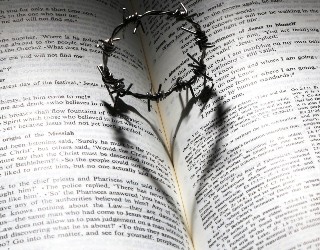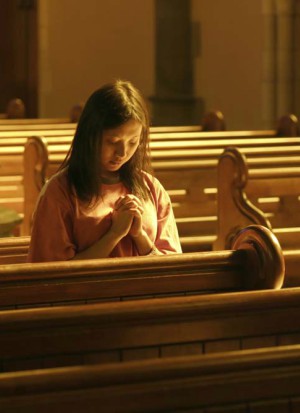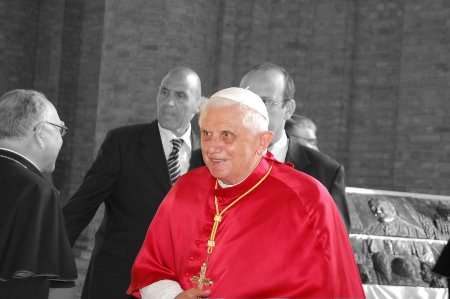We ask you, humbly: don't scroll away.
Hi readers, it seems you use Catholic Online a lot; that's great! It's a little awkward to ask, but we need your help. If you have already donated, we sincerely thank you. We're not salespeople, but we depend on donations averaging $14.76 and fewer than 1% of readers give. If you donate just $5.00, the price of your coffee, Catholic Online School could keep thriving. Thank you.Help Now >
Liturgy: Decorating the Sanctuary
FREE Catholic Classes
And More on Letting the Children Run
ROME, MAY 26, 2004 (Zenit) - Answered by Father Edward McNamara, professor of liturgy at the Regina Apostolorum Pontifical University.
Q: I have been searching for some type of directives regarding the decorating of the sanctuary. In the parish here we have a decorating committee that can do just about any type of decorating that it wants. Isn't there a book that contains what is permissible and what isn't? -- A.R., Hinckley, Ohio
A: By decoration I suppose you mean the occasional decoration of the sanctuary (flowers, etc.) and not the overall structure of the sanctuary itself.
The U.S. bishops' conference has recently published an official document, "Built of Living Stones," which gives concrete guidelines for many aspects of church construction and design.
The document may be obtained from the conference itself or from Catholic bookstores.
Apart from this, some general norms of the Church regarding decorating the sanctuary are contained in the General Instruction of the Roman Missal, in Nos. 304 and following, which address some aspects directly regarding the decoration of the altar but whose principles may be applied to the sanctuary in general.
No. 304 states: "Out of reverence for the celebration of the memorial of the Lord and for the banquet in which the Body and Blood of the Lord are offered on an altar where this memorial is celebrated, there should be at least one white cloth, its shape, size, and decoration in keeping with the altar's design. When, in the dioceses of the United States of America, other cloths are used in addition to the altar cloth, then those cloths may be of other colors possessing Christian honorific or festive significance according to longstanding local usage, provided that the uppermost cloth covering the mensa (i.e., the altar cloth itself) is always white in color."
No. 305 reminds us that: "Moderation should be observed in the decoration of the altar."
This applies especially to floral decorations, which "should always be done with moderation and placed around the altar rather than on its mensa," and which should be especially moderate during Advent and which are forbidden during Lent except for the Laetare Sunday (Fourth Sunday of Lent), as well as solemnities and feasts.
No. 306 gives as a principle that "Only what is required for the celebration of the Mass may be placed on the mensa of the altar: namely, from the beginning of the celebration until the proclamation of the Gospel, the Book of the Gospels; then from the Presentation of the Gifts until the purification of the vessels, the chalice with the paten, a ciborium if necessary, and, finally, the corporal, the purificator, the pall, and the Missal." A microphone is also permitted when necessary.
This means that any other elements or symbols should not be placed on the altar.
No. 308 requires the use of a "cross, with the figure of Christ crucified upon it, either on the altar or near it, where it is clearly visible to the assembled congregation. It is appropriate that such a cross, which calls to mind for the faithful the saving Passion of the Lord, remain near the altar even outside of liturgical celebrations."
No. 307 deals specifically with candles but also makes another valid criterion with respect to general decorum: "The candles ... are to be appropriately placed either on or around the altar in a way suited to the design of the altar and the sanctuary so that the whole may be well balanced and not interfere with the faithful's clear view of what takes place at the altar or what is placed on it."
Further on, No. 318 speaks of the use of sacred images: "In the earthly Liturgy, the Church participates, by a foretaste, in that heavenly Liturgy which is celebrated in the holy city of Jerusalem toward which she journeys as a pilgrim, and where Christ is sitting at the right hand of God; and by venerating the memory of the Saints, she hopes one day to have some part and fellowship with them.
"Thus, images of the Lord, the Blessed Virgin Mary, and the Saints, in accordance with the Church's most ancient tradition, should be displayed for veneration by the faithful in sacred buildings and should be arranged so as to usher the faithful toward the mysteries of faith celebrated there. For this reason, care should be taken that their number not be increased indiscriminately, and that they be arranged in proper order so as not to distract the faithful's attention from the celebration itself. There should usually be only one image of any given Saint. Generally speaking, in the ornamentation and arrangement of a church as far as images are concerned, provision should be made for the devotion of the entire community as well as for the beauty and dignity of the images."
We ask you, humbly: don't scroll away.
Hi readers, it seems you use Catholic Online a lot; that's great! It's a little awkward to ask, but we need your help. If you have already donated, we sincerely thank you. We're not salespeople, but we depend on donations averaging $14.76 and fewer than 1% of readers give. If you donate just $5.00, the price of your coffee, Catholic Online School could keep thriving. Thank you.Help Now >
From these numbers of the GIRM it may be inferred that what the Church desires with regard to the decoration of the sanctuary is an overall sense of moderation and well-balanced dignity, limiting, as far as possible, the use of merely decorative objects that have no direct liturgical function and avoidance of creating obstacles to the clear view of the assembly or impediments to its concentration on the celebration of the sacred mystery itself.
Thus, while the decoration of the sanctuary should remain fairly stable, there is ample space for traditional elements that reflect the liturgical season (Advent wreath, poinsettias at Christmastide, etc.) and for the occasional use of truly artistic banners on major feasts.
Although artistic banners may be used it is best to avoid the use of message posters in the sanctuary as well as other occasional articles such as children's drawings and the like which might draw attention away from the centrality of the celebration.
These objects are not necessarily excluded from the precincts of the church but should preferably be placed in some other suitable place outside the sanctuary.
* * *
Follow-up: Let the Children Run?
I received many comments from readers about toddlers running around church (see May 11). Some of the comments came from parents of large families who confirmed that it is possible to teach children to be quiet in Church, especially when given good example by mom and dad.
A few readers quoted Christ's words to me -- "Suffer the little children to come to me, for it is to such as these, the kingdom of heaven belongs" -- although it was not always clear if they quoted it for or against what I said.
If the text is taken to mean that children are welcome at Mass, I fully agree. If it is interpreted to mean that parents are somehow dispensed from teaching good manners to their children, then I cannot concur with such an exegesis.
There may of course be cases of parents who have children with special needs or conditions whose actions may cause occasional disruptions that cannot be attributed to bad behavior.
In such circumstances the parents require the support and the patience of the community, just as the children should not be deprived of God's grace in the midst of their difficulties.
At the same time, out of charity the parents should do all that is possible to take into account the needs of the other faithful, especially if they notice a particular agitation which might cause prolonged disruption.
 Hi readers, it seems you use Catholic Online a lot; that's great! It's a little awkward to ask, but we need your help. If you have already donated, we sincerely thank you. We're not salespeople, but we depend on donations averaging $14.76 and fewer than 1% of readers give. If you donate just $5.00, the price of your coffee, Catholic Online School could keep thriving. Thank you. Help Now >
Hi readers, it seems you use Catholic Online a lot; that's great! It's a little awkward to ask, but we need your help. If you have already donated, we sincerely thank you. We're not salespeople, but we depend on donations averaging $14.76 and fewer than 1% of readers give. If you donate just $5.00, the price of your coffee, Catholic Online School could keep thriving. Thank you. Help Now >
In especially grave cases, parents could attempt to rotate Mass schedules so as not to attend the same celebration always. Or they might even speak to the pastor to see if a special arrangement can be made for the Christian formation and sacramental life of these children.
Some correspondents asked particular questions regarding Masses specifically for children.
A Kentucky reader wrote: "Our pastor has several children's Masses for the students (K-8) during the year. Sometimes he invites all the children to stand with him around the altar. Some of the children are very young and not attentive. He also asks the children to raise their hands just as he does over the bread and wine during the consecration. This action seems to obscure the difference between the ordained priesthood and the laity and therefore is not edifying to the children. Is the priest acting correctly or is either of these practices prohibited?"
The directory for children does allow for some adaptations of the rite for children's Masses, understood above all as weekday celebrations at which the vast majority are youngsters. But having the little ones stand around the altar is not one of them.
In some circumstances such as a church with a distant altar that hinders communication with children, it is probably preferable, as suggested by No. 25 of the Directory for Masses with Children, to celebrate the Mass in another worthy place.
Thus, while it is good that the children be close to the altar of celebration, some form of distinction should remain between the two spaces.
In a similar fashion, while the directory's Nos. 33-34 do allow for some adaptation of gestures (above all, encouraging processions), having the children raise their hands during the consecration is, like gathering around the altar, more likely to confuse them about the Church's Eucharistic faith.
As No. 21 of the directory states: "It is always necessary to keep in mind that these eucharistic celebrations must lead children toward the celebration of Mass with adults, especially in the Masses at which the Christian community must come together on Sundays. Thus, apart from adaptations that are necessary because of the children's age, the result should not be entirely special rites, markedly different from the Order of Mass celebrated with a congregation. The purpose of the various elements should always correspond with what is said in the General Instruction of the Roman Missal on individual points, even if at times for pastoral reasons an absolute identity cannot be insisted upon."
Contact
Catholic Online
https://www.catholic.org
CA, US
Catholic Online - Publisher, 661 869-1000
info@yourcatholicvoice.org
Keywords
Liturgy, Sanctuary, Priest, Bishop
More Catholic PRWire
Showing 1 - 50 of 4,716
A Recession Antidote
Randy Hain
Monaco & The Vatican: Monaco's Grace Kelly Exhibit to Rome--A Review of Monegasque-Holy See Diplomatic History
Dna. Maria St. Catherine Sharpe, t.o.s.m., T.O.SS.T.
The Why of Jesus' Death: A Pauline Perspective
Jerom Paul
A Royal Betrayal: Catholic Monaco Liberalizes Abortion
Dna. Maria St.Catherine De Grace Sharpe, t.o.s.m., T.O.SS.T.
Embrace every moment as sacred time
Mary Regina Morrell
My Dad
JoMarie Grinkiewicz
Letting go is simple wisdom with divine potential
Mary Regina Morrell
Father Lombardi's Address on Catholic Media
Catholic Online
Pope's Words to Pontifical Latin American College
Catholic Online
Prelate: Genetics Needs a Conscience
Catholic Online
State Aid for Catholic Schools: Help or Hindrance?
Catholic Online
Scorsese Planning Movie on Japanese Martyrs
Catholic Online
2 Nuns Kidnapped in Kenya Set Free
Catholic Online
Holy See-Israel Negotiation Moves Forward
Catholic Online
Franchising to Evangelize
Catholic Online
Catholics Decry Anti-Christianity in Israel
Catholic Online
Pope and Gordon Brown Meet About Development Aid
Catholic Online
Pontiff Backs Latin America's Continental Mission
Catholic Online
Cardinal Warns Against Anti-Catholic Education
Catholic Online
Full Circle
Robert Gieb
Three words to a deeper faith
Paul Sposite
Relections for Lent 2009
chris anthony
Wisdom lies beyond the surface of life
Mary Regina Morrell
World Food Program Director on Lent
Catholic Online
Moral Clarity
DAN SHEA
Pope's Lenten Message for 2009
Catholic Online
A Prayer for Monaco: Remembering the Faith Legacy of Prince Rainier III & Princess Grace and Contemplating the Moral Challenges of Prince Albert II
Dna. Maria St. Catherine Sharpe
Keeping a Lid on Permissiveness
Sally Connolly
Glimpse of Me
Sarah Reinhard
The 3 stages of life
Michele Szekely
Sex and the Married Woman
Cheryl Dickow
A Catholic Woman Returns to the Church
Cheryl Dickow
Modernity & Morality
Dan Shea
Just a Minute
Sarah Reinhard
Catholic identity ... triumphant reemergence!
Hugh McNichol
Edging God Out
Paul Sposite
Burying a St. Joseph Statue
Cheryl Dickow
George Bush Speaks on Papal Visit
Catholic Online
Sometimes moving forward means moving the canoe
Mary Regina Morrell
Action Changes Things: Teaching our Kids about Community Service
Lisa Hendey
Easter... A Way of Life
Paul Spoisite
Papal initiative...peace and harmony!
Hugh McNichol
Proclaim the mysteries of the Resurrection!
Hugh McNichol
Jerusalem Patriarch's Easter Message
Catholic Online
Good Friday Sermon of Father Cantalamessa
Catholic Online
Papal Address at the End of the Way of the Cross
Catholic Online
Cardinal Zen's Meditations for Via Crucis
Catholic Online
Interview With Vatican Aide on Jewish-Catholic Relations
Catholic Online
Pope Benedict XVI On the Easter Triduum
Catholic Online
Holy Saturday...anticipation!
Hugh McNichol












 Daily Readings for Thursday, April 18, 2024
Daily Readings for Thursday, April 18, 2024 St. Apollonius the Apologist: Saint of the Day for Thursday, April 18, 2024
St. Apollonius the Apologist: Saint of the Day for Thursday, April 18, 2024 Aspiration: Prayer of the Day for Thursday, April 18, 2024
Aspiration: Prayer of the Day for Thursday, April 18, 2024
